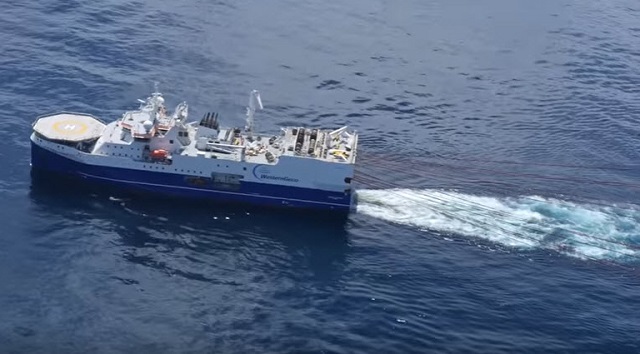Greenpeace Makes Contact with Seismic Vessel
Greenpeace crew have made contact with the world’s biggest seismic vessel after travelling 50 nautical miles on two rigid-hulled inflatables off the coast of Wairarapa, New Zealand.
The boat crews, consisting of members from Greenpeace and local iwi, located the seismic ship, Amazon Warrior, surveying the East Coast of New Zealand on behalf of Statoil and Chevron.
 From on board one of the inflatables, Greenpeace campaigner Kate Simcock radioed the master of the Amazon Warrior to deliver an open letter of protest signed by over 60,000 New Zealanders.
From on board one of the inflatables, Greenpeace campaigner Kate Simcock radioed the master of the Amazon Warrior to deliver an open letter of protest signed by over 60,000 New Zealanders.
Polynesian voyaging waka captain and East Coast resident, Reuben Raihania Tipoki (Ng?ti Kahungunu), also delivered a message on behalf of over 80 indigenous communities from the East Coast of New Zealand, demanding Statoil and Chevron cease activities in their customary waters.
“The burning of fossil fuels is changing our world - we are changing our world. We are calling in Armageddon, and it will be destruction by our own hands,” he says.
“If we are to stem climate change, indigenous philosophies about how to fit in with nature and not expect nature to fit in with us must be re-adopted.”
From on board, Greenpeace climate campaigner, Kate Simcock, says: “In order to find oil, it’s blasting sound waves into the ocean every eight seconds, 24 hours a day, from massive arrays that are the length of 80 rugby fields.”
The Amazon Warrior currently has two support vessels in the vicinity: Ocean Pioneer, a New Zealand-owned fishing vessel often used as support by the oil industry and the Maria G, a supply ship from Panama.
Simcock says Greenpeace made the 120 nautical miles trip to find the seismic blasting ship because it seems to have been avoiding coming into port where it could face protest.
This includes illegally switching off its mandatory AIS tracking safety device for days on end, alleges Greenpeace, throughout the 7.8 earthquake and tsunami threat and having people and supplies delivered to it by boat and helicopter.
“The Marine Mammal Impact Assessment (MMIA) was also not published until we asked for it. These examples highlight why it's more important than ever to have citizens monitoring this climate killing industry. They're clearly not being regulated well by the Government.
“Our message to the Government and the oil industry is this: The ocean isn’t as big as it may seem. We will show New Zealanders exactly how you are blasting our marine environment and causing distress to our unique whales and dolphins - all in the name of climate-wrecking oil - and we will peacefully resist you until you leave our waters.”
Meanwhile, New Zealand Petroleum and Energy granted a new petroleum exploration permit in December, stating that the number of bids received was lower than in previous years. Global bid rounds such as New Zealand’s annual Block Offer are continuing despite the economic downturn, said the regulator.
Current exploration activity is also continuing. In 2016, significant investments in seismic acquisition were made in the New Caledonia Basin and the onshore Taranaki Kapuni 3D seismic survey. There are also several offshore 3D seismic surveys occurring over the 2016/17 summer.
.jpg) On board the Margaret Mahy, Greenpeace’s Simcock delivered a message directly to the master of the Amazon Warrior:
On board the Margaret Mahy, Greenpeace’s Simcock delivered a message directly to the master of the Amazon Warrior:
“Amazon Warrior. Amazon Warrior. Amazon Warrior.
This is the Greenpeace Rhib Margaret Mahy. Margaret Mahy. Margaret Mahy. Do you copy?
This is a peaceful protest. We will not put you, your ship or crew in any danger.
We are here to oppose the seismic blasting for oil that you are doing and we, along with over 60,000 New Zealanders who have signed on to the following letter, demand that you cease immediately.
The world is facing a climate crisis.
Do you copy?
Climate change is a global threat from which no one is safe. It impacts every person, community and every living thing on earth. Including my family and your family also.
The science is very clear - we must stop burning oil, gas and coal.
If we are to avoid catastrophic climate change we can’t afford to burn even known reserves of oil let alone the new oil that you are looking for.
The seismic blasting that you are doing and the deep sea oil drilling that Statoil and Chevron want to do at extreme depths in our precious oceans also bring immediate impacts and risks.
Our oceans are a place rich in wildlife: With dolphins, whales, penguins, albatross, seals and sea lions, fish, crayfish, shellfish and whole oceanic ecosystems that are unique and many of which are rare and endangered.
We have a deep connection with our ocean. It is where we fish for our food. It is where we spend time with our families and how we make a living. It is central to our lives.
For the sake of our oceans, our climate, our coastlines and for our own sake, we are determined to ensure that deep sea oil drilling does not happen here.
Just as Greenpeace, in alliance with local iwi and communities, successfully resisted the deep sea drilling plans of Petrobras, then Anadarko, and then Statoil in Northland, we will also resist deep sea oil drilling by Statoil and Chevron here in Te Ikaroa.
I repeat our request and demand that you abandon your search for oil to drill in our oceans and leave immediately for the sake of your family, my family and all of our children and grandchildren.
You are not welcome here.
We will resist you and defend our oceans and the world’s climate with every peaceful means at our disposal.
Haere ra.
Margaret Mahy standing by on 16.”
